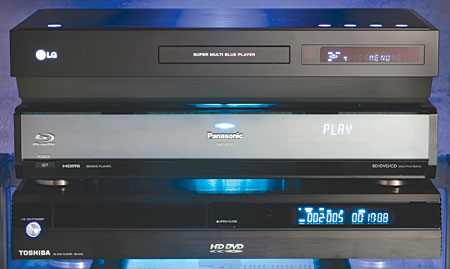Blu-ray and HD DVD Face Off
LG shocked the consumer electronics world at CES when they announced that, not only were they coming out with a player that would play Blu-ray and HD DVD, but it would be shipping in less than a month. True to their word, it did, and I got one in to try out. Around the same time, Toshiba released a pair of second-generation HD DVD players. The model I look at here, the HD-XA2, is notable as it is the first HD DVD player to output 1080p. The Blu-ray camp (seeing as they had just released most of their players) had no such exciting newness beyond what you read about in our April issue. So, we got in the Panasonic DMP-BD10 Blu-ray player, which is unique in that it doesn't seem to be a clone of any other players (which you can't say for many of the BD players out there). Where should your money go (if at all)? Just keep reading.

The Formats
Released first, HD DVD has 15 gigabytes per layer, and most discs are of the dual-layer 30-GB variety. A 51-GB tri-layer disc was recently announced, but it's not here yet. Many discs have a DVD version of the movie on the opposite side. Blu-ray, on the other hand, uses the same blue-violet laser as its nemesis, but it pulls off 25 GB per layer. It accomplishes this because the recorded layer is closer to the disc's surface. Some discs are 50 GB, but not many.
Sony, Blu-ray's biggest proponent, was responsible for the largest number of Blu-ray releases following the format's launch. The vast majority of these were greatly inferior in image quality compared with the available HD DVD titles. Warner, no stranger to releasing a new format, had dozens of pristine titles available at launch and afterward for HD DVD. With Warner and others now releasing on Blu-ray, the picture-quality gap is now on a per-title basis. Due to the numbers of releases, there are far more bad-looking Blu-ray titles than bad-looking HD DVD titles, but there are certainly good and bad in both formats.
Universal is the only company that is exclusively in the HD DVD camp. Warner, Paramount, and New Line release on both formats. Sony (obviously), MGM, Disney, and Fox are solely in the Blu-ray camp.

Both formats can use the same video codecs. MPEG-2, which is found on DVD and broadcast HDTV, usually isn't found on HD DVD (although it could be), while Sony has been using it almost exclusively on their Blu-ray releases. Many people wondered if Sony's insistence on using MPEG-2 was the reason behind the poor image quality of many of their early releases. This probably isn't the case, as MPEG-2 can look very good. VC-1, also called WMV 9 or SMPTE 421M, was developed by Microsoft. It is found on both formats and is seemingly the most popular of the next-generation codecs. H.264, or MPEG-4 Part 10, isn't found on as many titles as VC-1 or MPEG-2, but it's another choice for either format. It's nearly impossible to say which of the compression formats is best, as there isn't common material with which to compare them. One thing is certain: MPEG-2 takes up far more space than its newer counterparts. Also of note: Both formats have 1080p/24 on their discs.
On the audio side, most Blu-ray titles have Dolby Digital for their low-resolution choice and uncompressed linear PCM for their high-resolution choice. There is an option for Dolby TrueHD (which hasn't been seen much) and DTS-HD Master Audio (found on many Fox titles). With HD DVD, every disc has Dolby Digital Plus, which your player can downconvert to Dolby Digital. Some discs also have Dolby TrueHD. DTS-HD Master Audio and uncompressed PCM are also possibilities but so far haven't been on many discs.
























































